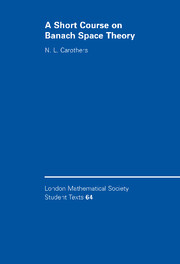Book contents
- Frontmatter
- Contents
- Preface
- 1 Classical Banach Spaces
- 2 Preliminaries
- 3 Bases in Banach Spaces
- 4 Bases in Banach Spaces II
- 5 Bases in Banach Spaces III
- 6 Special Properties of c0, l1, and l∞
- 7 Bases and Duality
- 8 Lp Spaces
- 9 Lp Spaces II
- 10 Lp Spaces III
- 11 Convexity
- 12 C(K) Spaces
- 13 Weak Compactness in L1
- 14 The Dunford–Pettis Property
- 15 C(K) Spaces II
- 16 C(K) Spaces III
- Appendix Topology Review
- References
- Index
2 - Preliminaries
Published online by Cambridge University Press: 06 January 2010
- Frontmatter
- Contents
- Preface
- 1 Classical Banach Spaces
- 2 Preliminaries
- 3 Bases in Banach Spaces
- 4 Bases in Banach Spaces II
- 5 Bases in Banach Spaces III
- 6 Special Properties of c0, l1, and l∞
- 7 Bases and Duality
- 8 Lp Spaces
- 9 Lp Spaces II
- 10 Lp Spaces III
- 11 Convexity
- 12 C(K) Spaces
- 13 Weak Compactness in L1
- 14 The Dunford–Pettis Property
- 15 C(K) Spaces II
- 16 C(K) Spaces III
- Appendix Topology Review
- References
- Index
Summary
We begin with a brief summary of important facts from functional analysis – some with proofs, some without. Throughout, X, Y, and so on, are normed linear spaces over ℝ. If there is no danger of confusion, we will use ∥ · ∥ to denote the norm in any given normed space; if two or more spaces enter into the discussion, we will use ∥ · ∥X, and so forth, to further identify the norm in question.
Continuous Linear Operators
Given a linear map T : X → Y, recall that the following are equivalent:
(i) T is continuous at 0 ∈ X.
(ii) T is continuous.
(iii) T is uniformly continuous.
(iv) T is Lipschitz; that is, there exists a constant C < ∞ such that ∥ T x – T y ∥Y ≤ C∥ x – y ∥X for all x, y ∈ X.
(v) T is bounded; that is, there exists a constant C < ∞ such that ∥T x∥Y ≤ C∥x∥X for all x ∈ X.
If a linear map T : X → Y is bounded, then there is, in fact, a smallest constant C satisfying ∥T x∥Y ≤ C∥x∥X for all x ∈ X. Indeed, the constant
called the norm of T, works; that is, it satisfies ∥T x∥Y ≤ ∥T ∥ ∥x∥X and it's the smallest constant to do so. Further, it's not hard to see that (2.1) actually defines a norm on the space B(X, Y) of all bounded, continuous, linear maps T : X → Y.
- Type
- Chapter
- Information
- A Short Course on Banach Space Theory , pp. 11 - 23Publisher: Cambridge University PressPrint publication year: 2004



